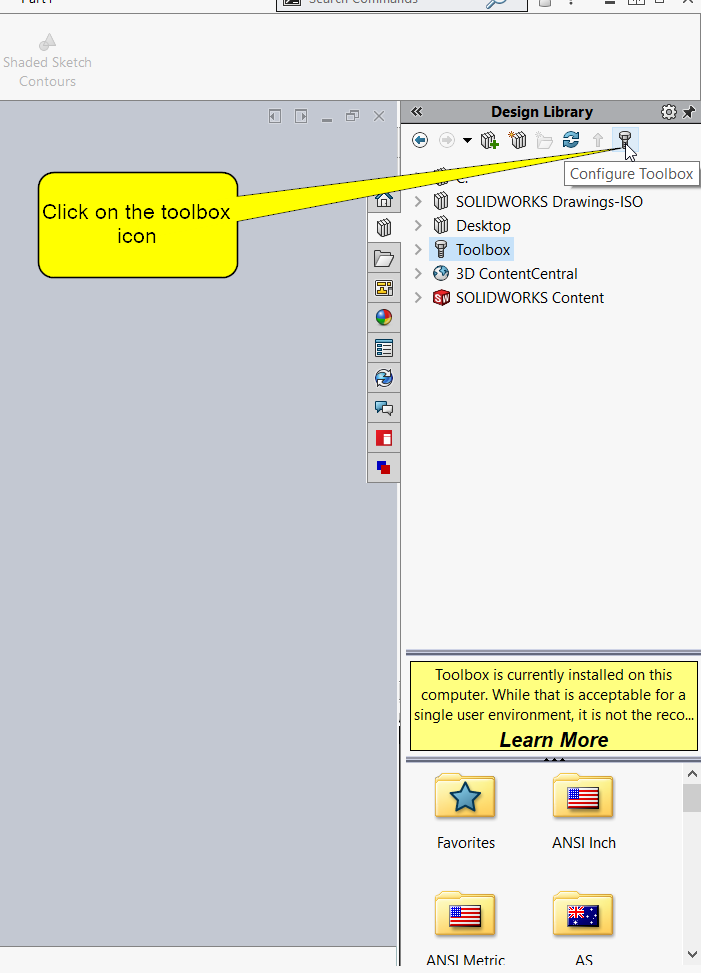


SOLIDWORKS TOOLBOX UPDATE FULL
28 pre-defined equations and multiphysics modes in 1D, 2D Cartesian and cylindrical coordinates, as well as full 3D.Support for structured and un-structured line interval, triangles, quadrilaterals, tetrahedral, and hexahedral mesh elements.Extensive FEM basis function library (linear and high order conforming P 1-P 5, non-conforming, bubble, and vector FEM discretizations).Fully cross platform MATLAB interoperability including other toolboxes.Stand-alone operation (without MATLAB) or can be used as a MATLAB toolbox.If requested instead of the built-in mesh generation algorithm, FEATool will convert and export appropriate Gridgen2D, Gmsh, or Triangle input data files, call the mesh generators through external system calls, and re-import the resulting grids into FEATool. Similar to the external solver interfaces, FEATool features built-in support for the Gmsh and Triangle mesh generators.

SOLIDWORKS TOOLBOX UPDATE GENERATOR
sdim = ) p_cyl_front = evalexpr ( 'p', , fea ) p_cyl_back = evalexpr ( 'p', , fea ) delta_p_computed = p_cyl_front - p_cyl_back delta_p_reference = 0.117520 External mesh generator interfaces Specifically, custom partial differential equations (PDE) and expressions can simply be entered and evaluated as string expressions as-is, without need for further compilation or writing custom functions. The short MATLAB script below illustrates how a complete flow around a cylinder computational fluid dynamics (CFD) benchmark problem can be defined and solved with the FEATool m-script functions (including geometry, grid generation, problem definition, solving, and postprocessing all in a few lines of code). GUI operation is recorded as equivalent function calls, and therefore in addition to binary formats, FEATool simulation models can also be saved and exported as fully scriptable and editable MATLAB compatible m-script files. Using the FEATool-FEniCS interface, as both codes feature PDE definition languages, multiphysics problems can automatically be translated and converted to FEniCS Python definition files, after which system calls to the FEniCS solver is made, and the resulting solution re-imported. Similar to the OpenFOAM and SU2 solver interfaces, FEATool also features a fully integrated interface to the FEniCS general FEM and multiphysics solver. In this way more advanced, larger, and parallel CFD models, for example including turbulence, can be simulated without leaving the FEATool interface.įEniCS multiphysics solver interface Using the interfaces automatically converts incompressible Navier-Stokes FEATool models to compatible OpenFOAM/SU2 mesh, boundary, and control dictionary files, runs simulations, and afterwards imports and interpolates the resulting solutions back into FEATool. The CFD solver interfaces allows fluid dynamics problems to be solved with the finite volume CFD solvers OpenFOAM and SU2. This feature enables these solvers to be used from the FEATool GUI and CLI without detailed knowledge of the syntax or peculiarities of each solver. OpenFOAM and SU2 CFD solver interfaces įEATool has introduced a multi-simulation feature whereby interfaces to popular academic and open-source solvers are developed. In this way FEATool can make up for any performance overhead by saving users time with problem set up and analysis. Specifically, because of the full integration of CAD and simulation tools users can switch between pre-processing, analysis, and post-processing modes to change simulation parameters, modify geometry and meshes, to solution evaluation and visualization. The FEATool graphical user interface (GUI) shown above was designed for ease of use and minimal prerequisite knowledge. Postprocessing and visualization of results


 0 kommentar(er)
0 kommentar(er)
